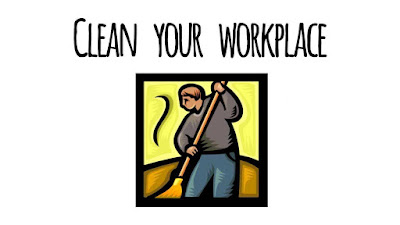After completion Seiri and
Seiton (that are the 1st
two steps of Lean tools
5S), Now the next
step is to implement the third Seiso or Shine.
Seiso is the third stage of 5S (Lean’s Most effective tools) method. Seiso (to make everything shiny clean) is a term that suggests you a
highly productive work environment should be clean. Seiso is a Japanese
word which means shiny, sweeping or cleaning or systematic cleaning, when using
5S refers relates to cleaning workplace
and all equipment and keeps it clean, neat and systematized. Seiso means remove dust and dirt from
a workplace. This 5S (Seiso) is
being an operative Lean Manufacturing apparatus which
helps with not just your housekeeping, but with enhancing your efficiencies,
improving safety, and ensuring
standardized ways of working. 5s benefits are based around the fact that it will help to remove the S7even wastes of Lean engineering from the manners. It
has also an advantage to inspecting the apparatuses during the cleaning period,
whereby leakage problems, breakdowns, failures, or any type of leakage are
identified.
Seiso has 2 most important goals. Those are:
1. To set the new Level for cleanliness.
2. To learn how to keep up that level of cleanliness.
Cleaning is thoroughly related to the proper functioning of
the apparatus and the ability to produce quality goods.
Implementation:
1. At 1st we need to identify the source of dirt
and contagion to take root shares for throwing away. Otherwise it would be
impossible to keep clean and in good working area.
2. Add cleaning as a part of daily work. A regular cleaning
process can be used as a visual inspection of apparatus or the workshop capability.
Just as you might notice corrosion or a scrape when washing your car – and not
notice it if you just get in and drive – so the workers will have opportunities
to catch problems in their early stages. As an example: we had to clean a small
puddle of hydraulic fluid – what does this mean about the state of the apparatus?
Even this one-time activity links in with the previous steps
of Seiri and Seiton. While acting the one-time "shiny
clean" activity, the work teams should ask themselves questions and note
the answers:
1. Does dirt
cause problems in operating the apparatus?
2. Is gravel
causing the machinery to wear rashly?
3. Is the work
station clean enough for safety and comfort?
4. What does
the "grime" tell us about the apparatus (like the leaking hydraulic
fluid example)?
5. Is the
"mud" – especially powder, gas or liquid – harmful or toxic?
6. What apparatuses,
chemicals or procedures are appropriate?
7. Could uncaring
scrubbing actually damage the apparatus?
8. Could we implement
routine maintenance – like checking the engine oil when washing your car – be executed
while cleaning?
9. Was "clay"
hiding any problems, such as decomposing apparatus or uneven floors?
This Seiso steps
should be functional before a factory setting and before physical cleanliness. For
example guess an office partition. Is dirt adding on a picket of papers? Why are
the papers sitting there, relatively than being filed appropriately? Are the
computer’s air outlets congested? Are outmoded booklets stored on the computer relatively
than on a network backup?
1. Setting the standard for future
cleanliness.
2. Less lost time for maintenances,
since apparatus will be inspected concisely but frequently, and because there
will be less grime clogging the apparatus.
3. Reduce potential risk of accidents.
4. Improving the physical and mental welfare
worker.
5. The useful life of the apparatus is
increased to inhibit any decline from pollution and dirt.
6. The cleaning leads to a significant
increase, in overall apparatus are in top form cleaning.
7. Wastage of materials and energy due
to the abolition of leaks and leaks are reduced.
8. The quality of Productions is upgraded
and losses are avoided by dirt and contagion of the product and packaging.
1. Actually acting the work validates
what was planned – or extends the planning with reality.
2. Lists of.
3. Tasks.
4. Tools, apparatus, detergents or
cleansers required for each task;
5. Series of tasks – wash the machinery
before swabbing the floor.
6. Actual times required by the various chores.
7. Maintenances required, as noted
during the inspections.
8. Ideas for development – when you do
the cleaning yourself you will acquire ideas on how to make the work easier in
the future
9. Employee buy-in: they did the work
and therefore they know it can be done and how long it took to do it the first
time.
Written By:
Md. Farid Ahmed
IE Officer
Fakir Apparels Ltd.
BSCIC Industrial Area, Enayet Nagar,
Fatulla,Narayangonj, Bangladesh.
Mobile: 8801814220987
E-mail: farid.ieconcern@gmail.com
Md. Farid Ahmed
IE Officer
Fakir Apparels Ltd.
BSCIC Industrial Area, Enayet Nagar,
Fatulla,Narayangonj, Bangladesh.
Mobile: 8801814220987
E-mail: farid.ieconcern@gmail.com



No comments:
Post a Comment